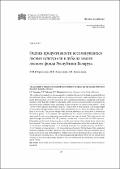| dc.description.abstract | The results of the research on the assessment of complex efficiency of the lands occupied with not closed forest cultures of the spruce and the oak in mossy, bracken, oxalis and bilberry types of forest. Determination of forest resources in not closed forest cultures are conducted in 10 model forestries of the Republic of Belarus. The results of the research have shown that wood reserves in not closed forest cultures change depending on the wood type: in cultures of the spruce – from 1,64 to 4,30 m3/hectare, in cultures of the oak – from 2,42 to 4,13 m3/hectare. The average height of seven-year-old trees varies in cultures of the spruce from 1,02 to 1,96 m, in cultures of the oak – from 1,4 to 1,6 m. The greatest values of the elevated phytomass in a fresh state is observed in bracken fir groves – 4,5 t/hectare. The deposition of CO2 in not closed forest cultures of the spruce and the oak varies depending on wood breed and type of wood. This indicator for the sprucechanges from 0,033 to 0,157 t/hectare, for the oak – from 0,010 to 0,030 t/hectare. Dependence of the stock of forest resources on the type of wood of not closed forest cultures has been noticed. The greatest reserve of seven-year-old wood is observed in the bracken fir grove – 4,3 m3/hectare (average density – 2,7 thousand piece/hectare) and the bracken oak forest – 4,1 m3/hectare (average density – 2,6 thousand pieces/hectare). On the basis of the conducted research standards of complex efficiency of not closed forest cultures of the spruceand the oak on lands of the forest fund of the Republic of Belarus have been developed. They contain data on wood and non-wood resources, elevated phytomass and deposition of CO2 by not closed forest cultures on 1 hectare with average density of trees of 3,0 thousand pieces/hectare, at the middle age of 7 years. | en |
